The tool box market is anticipated to expand from USD 12.4 billion in 2025 to USD 26.8 billion in 2035, reflecting a CAGR of 8.0%. The absolute dollar opportunity over this period amounts to USD 14.4 billion, representing the incremental revenue potential available to manufacturers, distributors, and service providers. This growth is expected to be fueled by rising demand from industrial, automotive, construction, and consumer segments, driven by the need for durable, organized, and portable storage solutions. Companies offering modular, customizable, and high-quality tool boxes are likely to capture a significant portion of this opportunity.

Between 2025 and 2030, a considerable share of the dollar opportunity is anticipated as demand increases for home improvement, professional workshops, and small-scale industrial operations. The adoption of ergonomic and innovative designs, along with enhanced material quality, will contribute to incremental revenue during this phase. From 2030 to 2035, additional opportunity is expected through expansion into emerging markets, increased e-commerce penetration, and growing awareness of organized storage solutions in commercial and industrial sectors. The absolute dollar opportunity highlights a sizable potential for market participants to generate revenue, strengthen distribution networks, and introduce product innovations. The market trajectory suggests consistent growth, allowing stakeholders to strategically capture value while meeting evolving consumer and industrial needs.
| Metric | Value |
|---|---|
| Estimated Value in (2025E) | USD 12.4 billion |
| Forecast Value in (2035F) | USD 26.8 billion |
| Forecast CAGR (2025 to 2035) | 8.0% |
The global tool box market is primarily divided between professional-grade and consumer-grade segments. Professional-grade tool boxes dominate the market, accounting for approximately 70% of the share. This dominance is driven by the demand from industries such as construction, automotive, and manufacturing, where durable and efficient tool storage solutions are essential for daily operations. The consumer-grade segment holds the remaining 30%, catering to DIY enthusiasts and homeowners seeking portable and cost-effective storage options for personal use.
Recent developments in the tool box market indicate a shift towards enhanced functionality and user convenience. Manufacturers are focusing on designing tool boxes with modular compartments, ergonomic handles, and lightweight materials to improve portability and organization. The integration of smart technologies, such as built-in LED lighting and digital locks, is gaining traction to enhance security and usability. There is a growing emphasis on eco-friendly materials and sustainable manufacturing processes, responding to increasing consumer awareness and regulatory pressures. These innovations reflect the industry's commitment to meeting the evolving needs of both professional and consumer users.
Market expansion is being supported by the increasing global demand for construction and maintenance services and the corresponding need for portable storage solutions that can maintain tool security and organization while extending equipment lifespan across various professional applications. Modern professional users are increasingly focused on implementing storage solutions that can reduce tool search time, minimize equipment damage, and provide consistent accessibility in demanding work environments. Tool boxes' proven ability to deliver equipment protection, enhanced organization capabilities, and versatile application compatibility make them essential products for contemporary construction, automotive repair, and home improvement solutions.
The growing emphasis on workplace efficiency and equipment management is driving demand for tool boxes that can support professional productivity, reduce tool replacement costs, and enable organized storage of specialized equipment. Professional users' preference for storage solutions that combine durability with operational efficiency and portability is creating opportunities for innovative tool box implementations. The rising influence of modular storage trends and customization demands is also contributing to increased adoption of tool boxes that can provide adaptable organization solutions without compromising storage capacity or mobility.
The tool box market is poised for rapid growth and transformation. As professionals across construction, automotive, manufacturing, and home improvement sectors seek storage solutions that are durable, portable, secure, and organized, tool boxes are gaining prominence not just as basic storage containers but as strategic equipment management systems supporting workplace efficiency, tool protection, and inventory control.
Rising construction activity and infrastructure investment in Asia-Pacific, Latin America, and Africa amplify demand, while manufacturers are picking up on innovations in material technology and design improvements.
Pathways like smart storage integration, premium material construction, and modular design differentiation promise strong margin uplift, especially in mature markets. Geographic expansion and product localization will capture volume, particularly where construction activity is expanding or professional tool usage is growing. Regulatory pressures around workplace safety, equipment tracking, theft prevention, and professional standards give structural support.
The market is segmented by material type, capacity, end user, distribution channel, and region. By material type, the market is divided into metal, plastic, wood, and composite materials. By capacity, it covers small (up to 20 liters), medium (20-50 liters), large (50-100 liters), and extra-large (above 100 liters). By product type, it is segmented into portable tool boxes, chest tool boxes, rolling tool boxes, and tool bags. The design features include lockable, stackable, weather-resistant, and standard. Based on end user, the market is categorized into professional users, DIY enthusiasts, and industrial facilities. By distribution channel, the market includes hardware stores, home improvement centers, online retail, and specialty distributors. Regionally, the market is divided into North America, Europe, East Asia, South Asia & Pacific, Latin America, and the Middle East & Africa.
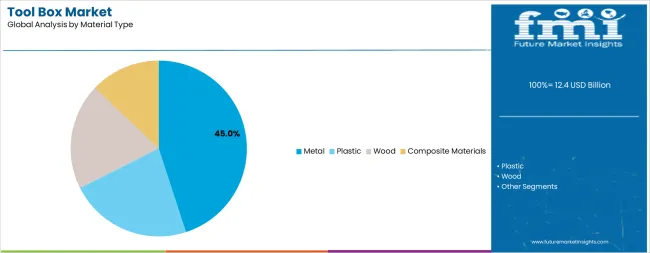
The metal segment is projected to account for 45.0% of the tool box market in 2025, reaffirming its position as the leading material category. Professional users increasingly utilize metal tool boxes for their superior durability, enhanced security features, and resistance to impact damage in demanding work environments across construction sites, automotive shops, and industrial facilities. Metal tool box technology's advanced manufacturing capabilities and consistent strength performance directly address the professional requirements for reliable equipment protection and long-term storage solutions in heavy-duty applications.
This material segment forms the foundation of professional storage operations, as it represents the construction material with the greatest durability and established market demand across multiple trade sectors and industrial applications. Manufacturer investments in enhanced corrosion-resistant coatings and lightweight alloy technologies continue to strengthen adoption among professional users. With construction companies prioritizing equipment security and impact resistance, metal tool boxes align with both operational durability objectives and professional storage requirements, making them the central component of comprehensive tool management strategies.
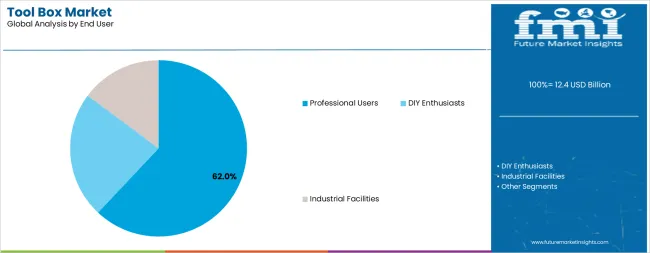
Professional users are projected to represent 62.0% of tool box demand in 2025, underscoring their critical role as the primary consumers of storage solutions for trade operations and commercial service applications. Professional tradespeople prefer tool boxes for their durability, organized storage capabilities, and ability to protect valuable equipment while reducing tool search time and handling complexity. Positioned as essential equipment for modern professional operations, tool boxes offer both productivity advantages and equipment protection benefits.
The segment is supported by continuous innovation in ergonomic design and the growing availability of specialized storage configurations that enable customized organization with enhanced mobility features. The professional users are investing in fleet management systems to support large-scale equipment procurement and inventory tracking. As construction activity becomes more prevalent and professional efficiency requirements increase, professional users will continue to dominate the end-user market while supporting advanced storage utilization and workplace productivity strategies.
The tool box market is advancing rapidly due to increasing demand for organized tool storage and growing adoption of portable storage solutions that provide equipment protection and efficient organization across diverse professional applications. The market faces challenges, including competitive pricing pressure from imported products, material cost fluctuations, and the need for advanced manufacturing equipment investments. Innovation in modular design technologies and smart storage solutions continues to influence product development and market expansion patterns.
The growing adoption of modular tool box systems and customizable storage configurations is enabling professional users to create tailored organization solutions with enhanced flexibility, improved accessibility, and optimized space utilization capabilities. Modular storage systems provide improved adaptability while allowing more efficient organization and consistent tool protection across various trade applications and work environments. Manufacturers are increasingly recognizing the competitive advantages of modular design capabilities for product differentiation and premium market positioning.
Modern tool box manufacturers are incorporating smart lock systems and GPS tracking technologies to enhance equipment security, enable inventory management, and ensure theft prevention for professional users. These technologies improve asset management efficiency while enabling new applications, including remote monitoring and automated inventory tracking. Advanced technology integration also allows manufacturers to support premium product positioning and professional requirements beyond traditional basic storage solutions.
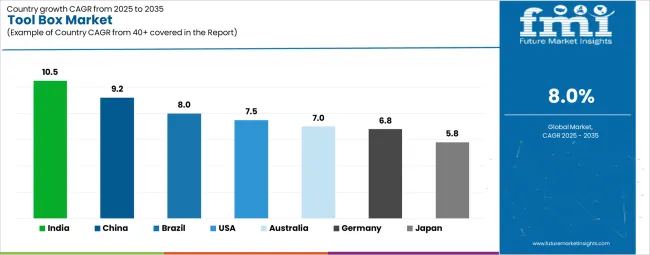
| Country | CAGR (2025-2035) |
|---|---|
| USA | 7.5% |
| China | 9.2% |
| India | 10.5% |
| Germany | 6.8% |
| Brazil | 8.0% |
| Japan | 5.8% |
| Australia | 7.0% |
The tool box market is experiencing strong growth globally, with India leading at a 10.5% CAGR through 2035, driven by the expanding construction sector, growing infrastructure investment, and significant increase in professional tradesperson population. China follows at 9.2%, supported by large-scale manufacturing activity, extensive construction projects, and growing demand for industrial storage solutions. The USA shows growth at 7.5%, emphasizing product innovation and professional-grade equipment demand. Brazil records 8.0%, focusing on construction sector expansion and industrial facility development. Germany demonstrates 6.8% growth, prioritizing premium quality products and advanced manufacturing technologies. Japan exhibits 5.8% growth, supported by precision manufacturing and specialized tool storage requirements. Australia shows 7.0% growth, driven by mining industry demand and residential construction activity.
The report covers an in-depth analysis of 40+ countries, Top-performing countries are highlighted below.
The demand for tool boxes in India is projected to exhibit exceptional growth with a CAGR of 10.5% through 2035, driven by expanding construction infrastructure and rapidly growing professional tradesperson population supported by government infrastructure development initiatives. The country's robust construction activity and increasing investment in manufacturing facilities are creating substantial demand for professional-grade storage solutions. Major hardware retailers and industrial distributors are establishing comprehensive distribution networks to serve both urban and rural markets.
The demand for tool boxes in China is expanding at a CAGR of 9.2%, supported by the country's large-scale manufacturing capacity, extensive construction activity, and increasing demand for industrial storage solutions and professional equipment organization. The country's comprehensive manufacturing supply chain and growing professional services sector are driving demand for diverse storage capabilities. International equipment providers and domestic manufacturers are establishing extensive production and distribution capabilities to address the growing demand for tool box products.
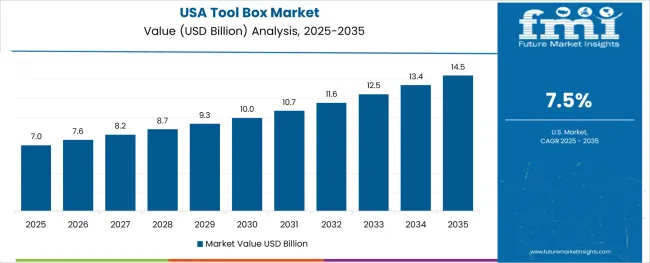
Revenue from tool boxes in the USA is expanding at a CAGR of 7.5%, supported by the country's mature construction industry, strong emphasis on product innovation, and robust demand for professional-grade equipment among skilled tradespeople. The nation's established professional services sector and high adoption of premium storage products are driving sophisticated tool box capabilities throughout the market. Leading manufacturers and retail chains are investing extensively in premium product development and advanced feature integration to serve both professional and consumer markets.
The tool boxes industry in Brazil is growing at a CAGR of 8.0%, driven by expanding construction activity, increasing infrastructure investment, and growing professional services sector development. The country's robust economic growth and modernization of industrial facilities are supporting demand for professional storage solutions across major development regions. Construction companies and automotive service providers are establishing comprehensive equipment procurement programs to serve both commercial projects and retail markets.
The demand for tool boxes in Germany is expanding at a CAGR of 6.8%, supported by the country's advanced manufacturing industry, emphasis on high-quality construction, and strong professional standards for tool management. Germany's established engineering tradition and precision manufacturing capabilities are driving demand for premium storage technologies focusing on durability and functional design. Manufacturers are investing in comprehensive production facilities to serve both domestic and international markets with professional-grade tool box products.
The demand for tool boxes in Japan is expanding at a CAGR of 5.8%, supported by the country's focus on precision manufacturing, specialized tool applications, and strong professional standards for equipment organization. Japan's sophisticated manufacturing industry and emphasis on quality construction are driving demand for advanced storage technologies including compact designs and specialized organization systems. Leading manufacturers are investing in specialized capabilities to serve automotive, electronics, and precision manufacturing sectors with premium tool box offerings.
The tool boxes market in Australia is expanding at a CAGR of 7.0%, driven by the country's robust mining industry, active construction sector, and growing demand for heavy-duty storage solutions in challenging work environments. Australia's extensive resource extraction operations and infrastructure development projects are supporting investment in durable storage capabilities throughout major industrial regions. Professional users are establishing comprehensive equipment management programs to serve remote work sites and urban construction projects.
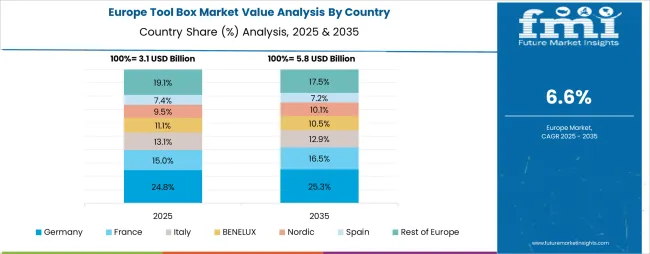
The tool box market in Europe is projected to grow from USD 2.8 billion in 2025 to USD 6.0 billion by 2035, registering a CAGR of 7.9% over the forecast period. Germany is expected to maintain its leadership position with a 32.0% market share in 2025, holding steady at 32.0% by 2035, supported by its strong manufacturing sector, extensive automotive repair industry, and comprehensive professional tool distribution network serving major European markets.
United Kingdom follows with a 20.0% share in 2025, projected to reach 19.5% by 2035, driven by robust demand for professional-grade tool boxes in construction and maintenance sectors, combined with established DIY culture and active home improvement market. France holds a 16.0% share in 2025, expected to maintain 16.0% by 2035, supported by strong construction activity and growing professional services sector. Italy commands a 12.0% share in 2025, projected to reach 12.5% by 2035, while Spain accounts for 9.0% in 2025, expected to reach 9.5% by 2035. The Netherlands maintains a 3.5% share in 2025, growing to 3.8% by 2035. The Rest of Europe region, including Nordic countries, Eastern Europe, Poland, Belgium, Switzerland, and Austria, is anticipated to gain momentum, expanding its collective share from 7.5% to 7.7% by 2035, attributed to increasing construction activity in Nordic countries and growing professional tool adoption across Eastern European markets implementing infrastructure modernization programs.
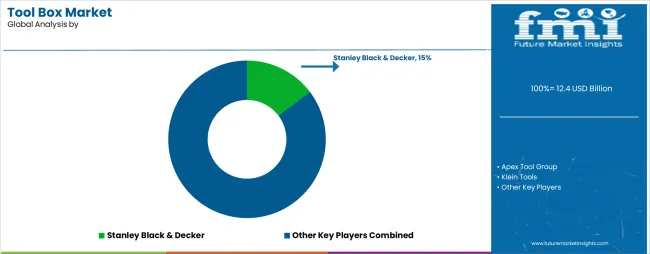
The tool box market is characterized by competition among established tool manufacturers, specialized storage system providers, and integrated equipment distributors. Companies are investing in advanced material research, ergonomic design optimization, modular system development, and comprehensive product portfolios to deliver durable, functional, and cost-effective tool box solutions. Innovation in locking mechanisms, mobility features, and weather-resistant construction is central to strengthening market position and competitive advantage.
Stanley Black & Decker leads the market with a strong market share, offering comprehensive tool storage solutions with a focus on professional applications and retail distribution. Apex Tool Group provides specialized industrial storage capabilities with an emphasis on durability and brand portfolio management. Klein Tools delivers professional-grade storage solutions with a focus on electrical trade applications and specialized organization. Milwaukee Tool specializes in heavy-duty storage systems and modular organization products for construction markets. Keter Group focuses on plastic storage solutions and consumer-oriented product development. RIDGID offers professional storage systems with emphasis on plumbing and mechanical trade applications.
| Items | Values |
|---|---|
| Quantitative Units (2025) | USD 12.4 billion |
| Material Type | Metal, Plastic, Wood, Composite Materials |
| Capacity | Small (up to 20L), Medium (20-50L), Large (50-100L), Extra-Large (above 100L) |
| Product Type | Portable Tool Boxes, Chest Tool Boxes, Rolling Tool Boxes, Tool Bags |
| Design Features | Lockable, Stackable, Weather-Resistant, Standard |
| End User | Professional Users, DIY Enthusiasts, Industrial Facilities |
| Distribution Channel | Hardware Stores, Home Improvement Centers, Online Retail, Specialty Distributors |
| Regions Covered | North America, Europe, East Asia, South Asia & Pacific, Latin America, Middle East & Africa |
| Countries Covered | United States, Canada, United Kingdom, Germany, France, China, Japan, South Korea, India, Brazil, Australia and 40+ countries |
| Key Companies Profiled | Stanley Black & Decker, Apex Tool Group, Klein Tools, Milwaukee Tool, Keter Group, and RIDGID |
| Additional Attributes | Dollar sales by material type and end user category, regional demand trends, competitive landscape, technological advancements in storage systems, security innovation, modular product development, and distribution channel optimization |
Material Type
The global tool box market is estimated to be valued at USD 12.4 billion in 2025.
The market size for the tool box market is projected to reach USD 26.8 billion by 2035.
The tool box market is expected to grow at a 8.0% CAGR between 2025 and 2035.
The key product types in tool box market are metal, plastic, wood and composite materials.
In terms of end user, professional users segment to command 62.0% share in the tool box market in 2025.






Our Research Products

The "Full Research Suite" delivers actionable market intel, deep dives on markets or technologies, so clients act faster, cut risk, and unlock growth.

The Leaderboard benchmarks and ranks top vendors, classifying them as Established Leaders, Leading Challengers, or Disruptors & Challengers.

Locates where complements amplify value and substitutes erode it, forecasting net impact by horizon

We deliver granular, decision-grade intel: market sizing, 5-year forecasts, pricing, adoption, usage, revenue, and operational KPIs—plus competitor tracking, regulation, and value chains—across 60 countries broadly.

Spot the shifts before they hit your P&L. We track inflection points, adoption curves, pricing moves, and ecosystem plays to show where demand is heading, why it is changing, and what to do next across high-growth markets and disruptive tech

Real-time reads of user behavior. We track shifting priorities, perceptions of today’s and next-gen services, and provider experience, then pace how fast tech moves from trial to adoption, blending buyer, consumer, and channel inputs with social signals (#WhySwitch, #UX).

Partner with our analyst team to build a custom report designed around your business priorities. From analysing market trends to assessing competitors or crafting bespoke datasets, we tailor insights to your needs.
Supplier Intelligence
Discovery & Profiling
Capacity & Footprint
Performance & Risk
Compliance & Governance
Commercial Readiness
Who Supplies Whom
Scorecards & Shortlists
Playbooks & Docs
Category Intelligence
Definition & Scope
Demand & Use Cases
Cost Drivers
Market Structure
Supply Chain Map
Trade & Policy
Operating Norms
Deliverables
Buyer Intelligence
Account Basics
Spend & Scope
Procurement Model
Vendor Requirements
Terms & Policies
Entry Strategy
Pain Points & Triggers
Outputs
Pricing Analysis
Benchmarks
Trends
Should-Cost
Indexation
Landed Cost
Commercial Terms
Deliverables
Brand Analysis
Positioning & Value Prop
Share & Presence
Customer Evidence
Go-to-Market
Digital & Reputation
Compliance & Trust
KPIs & Gaps
Outputs
Full Research Suite comprises of:
Market outlook & trends analysis
Interviews & case studies
Strategic recommendations
Vendor profiles & capabilities analysis
5-year forecasts
8 regions and 60+ country-level data splits
Market segment data splits
12 months of continuous data updates
DELIVERED AS:
PDF EXCEL ONLINE
Understanding Market Share Trends in the Tool Box Industry
Telescopic Tool Boxes Market Growth - Demand & Forecast 2025 to 2035
Portable Rolling Toolbox Market
Box Liners Market Size and Share Forecast Outlook 2025 to 2035
Tool Holders Market Size and Share Forecast Outlook 2025 to 2035
Boxboard Packaging Market Analysis - Size, Share, and Forecast Outlook 2025 to 2035
Box Compression Tester Market Size and Share Forecast Outlook 2025 to 2035
Tool Tethering Market Size and Share Forecast Outlook 2025 to 2035
Tool Steel Market Size and Share Forecast Outlook 2025 to 2035
Box Latch Market Size and Share Forecast Outlook 2025 to 2035
Box Pouch Market by Pouch Type from 2025 to 2035
Box Filling Machine Market from 2025 to 2035
Box and Carton Overwrap Films Market Demand and Growth
Box and Carton Overwrapping Machines Market Insights and Growth 2025 to 2035
Tool Presetter Market Trend Analysis Based on Product, Category, End-Use, and Region 2025 to 2035
Boxcar Scars Market – Demand, Growth & Forecast 2025 to 2035
Box Sealing Machines Market Trends – Growth & Forecast 2025 to 2035
Competitive Breakdown of Box Pouch Providers
Market Share Insights of Boxboard Packaging Providers
Box Latch Market Positioning & Competitive Analysis

Thank you!
You will receive an email from our Business Development Manager. Please be sure to check your SPAM/JUNK folder too.
Chat With
MaRIA